Health Promotion Competencies: Addressing Mental Health at UOW
VerifiedAdded on 2023/06/03
|12
|2793
|50
Report
AI Summary
This report assesses a health promotion program designed to address the mental health and social support needs of international students at the University of Wollongong (UOW). It identifies both positive and negative impacts of the proposed plan, including the potential for increased student confidence and the risk of discrimination among Australian students. The report also examines intended and unintended consequences, such as improved mental health support versus budgetary challenges and time constraints. Advocacy strategies, including lobbying, meetings, community organizing, and project visits, are discussed as tools to influence program outcomes. A risk assessment matrix is presented to evaluate potential risks associated with the planned strategies, such as low survey participation and communication barriers. The report concludes by emphasizing the importance of addressing mental health and wellbeing among international students through comprehensive and well-planned interventions.
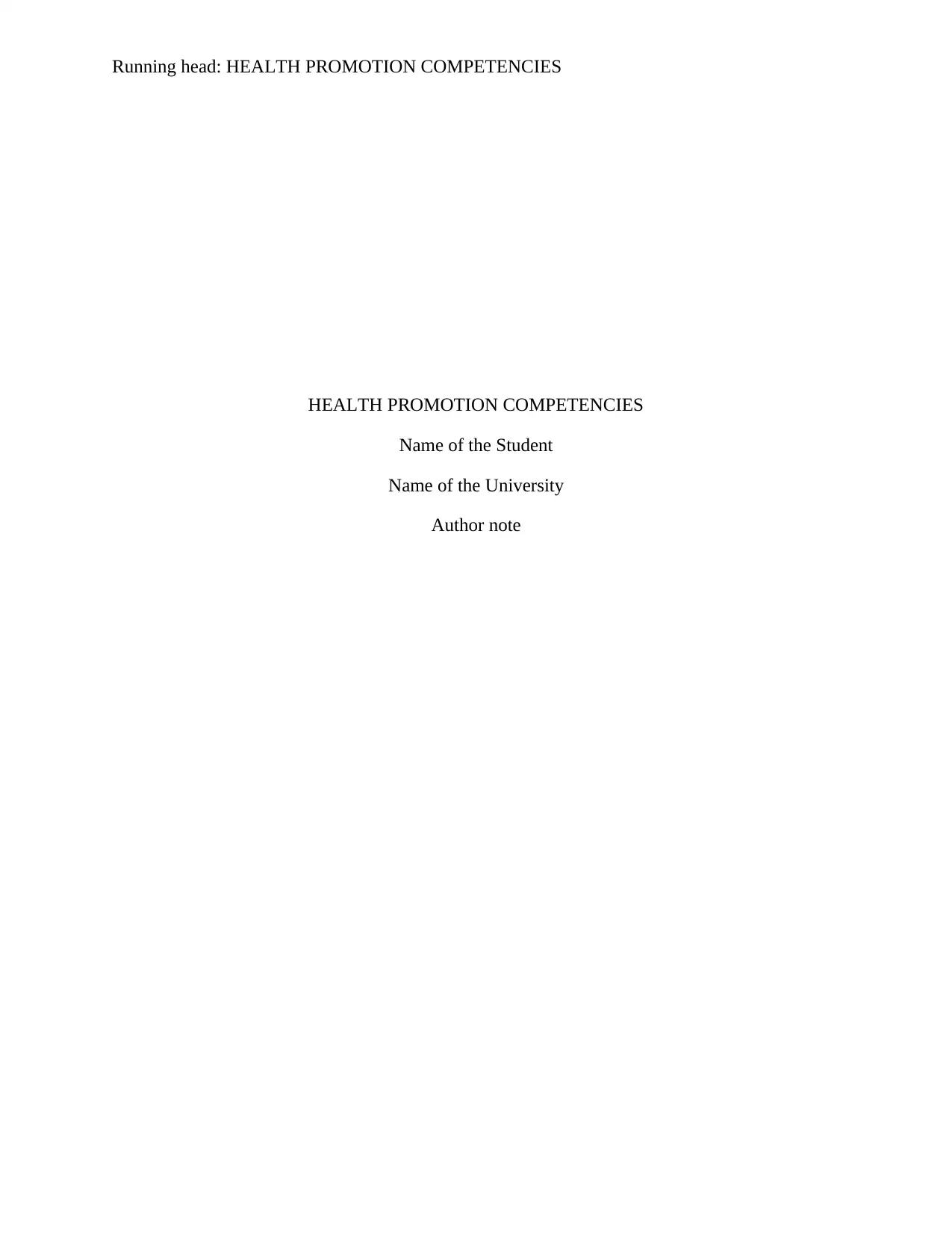
Running head: HEALTH PROMOTION COMPETENCIES
HEALTH PROMOTION COMPETENCIES
Name of the Student
Name of the University
Author note
HEALTH PROMOTION COMPETENCIES
Name of the Student
Name of the University
Author note
Paraphrase This Document
Need a fresh take? Get an instant paraphrase of this document with our AI Paraphraser
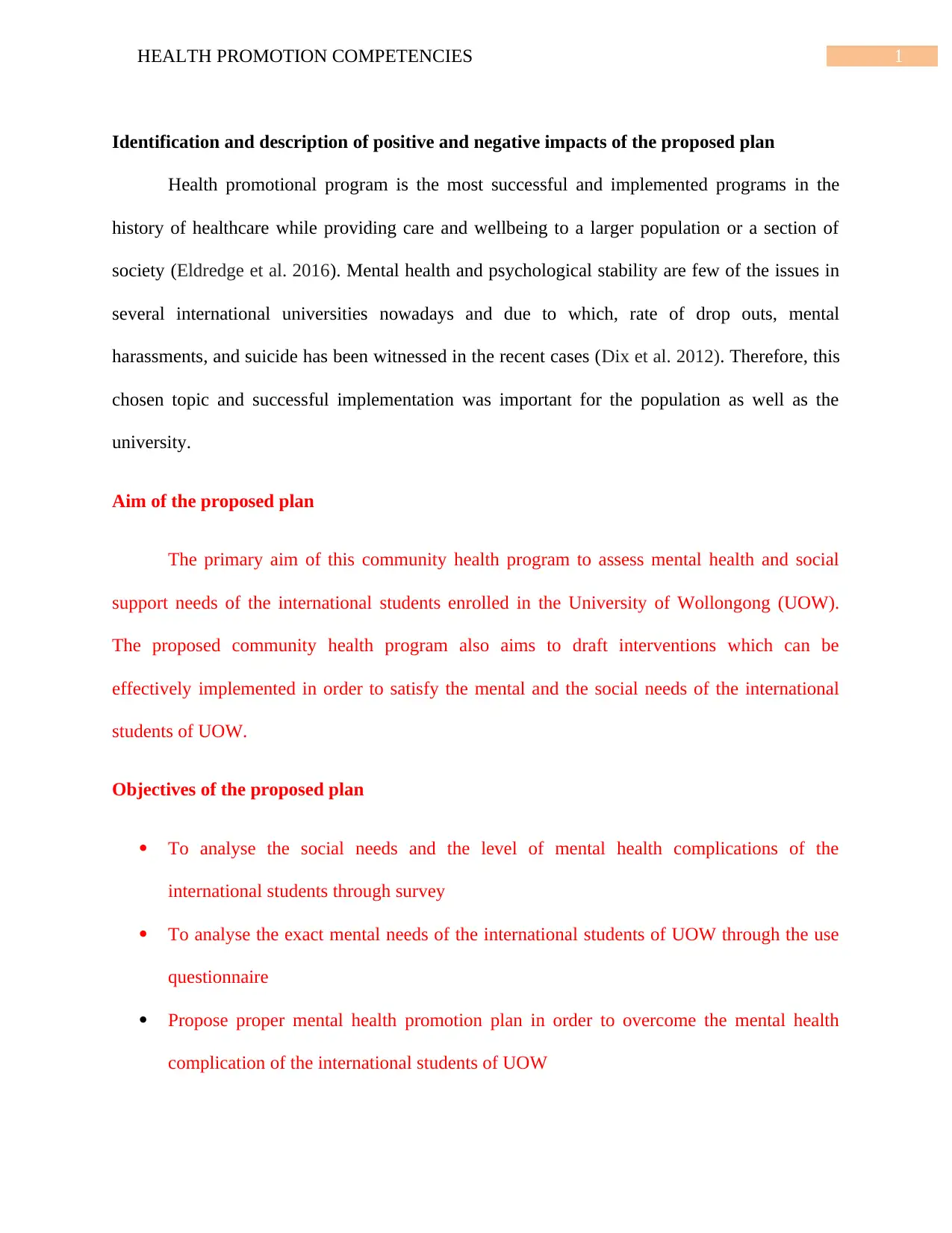
1HEALTH PROMOTION COMPETENCIES
Identification and description of positive and negative impacts of the proposed plan
Health promotional program is the most successful and implemented programs in the
history of healthcare while providing care and wellbeing to a larger population or a section of
society (Eldredge et al. 2016). Mental health and psychological stability are few of the issues in
several international universities nowadays and due to which, rate of drop outs, mental
harassments, and suicide has been witnessed in the recent cases (Dix et al. 2012). Therefore, this
chosen topic and successful implementation was important for the population as well as the
university.
Aim of the proposed plan
The primary aim of this community health program to assess mental health and social
support needs of the international students enrolled in the University of Wollongong (UOW).
The proposed community health program also aims to draft interventions which can be
effectively implemented in order to satisfy the mental and the social needs of the international
students of UOW.
Objectives of the proposed plan
To analyse the social needs and the level of mental health complications of the
international students through survey
To analyse the exact mental needs of the international students of UOW through the use
questionnaire
Propose proper mental health promotion plan in order to overcome the mental health
complication of the international students of UOW
Identification and description of positive and negative impacts of the proposed plan
Health promotional program is the most successful and implemented programs in the
history of healthcare while providing care and wellbeing to a larger population or a section of
society (Eldredge et al. 2016). Mental health and psychological stability are few of the issues in
several international universities nowadays and due to which, rate of drop outs, mental
harassments, and suicide has been witnessed in the recent cases (Dix et al. 2012). Therefore, this
chosen topic and successful implementation was important for the population as well as the
university.
Aim of the proposed plan
The primary aim of this community health program to assess mental health and social
support needs of the international students enrolled in the University of Wollongong (UOW).
The proposed community health program also aims to draft interventions which can be
effectively implemented in order to satisfy the mental and the social needs of the international
students of UOW.
Objectives of the proposed plan
To analyse the social needs and the level of mental health complications of the
international students through survey
To analyse the exact mental needs of the international students of UOW through the use
questionnaire
Propose proper mental health promotion plan in order to overcome the mental health
complication of the international students of UOW
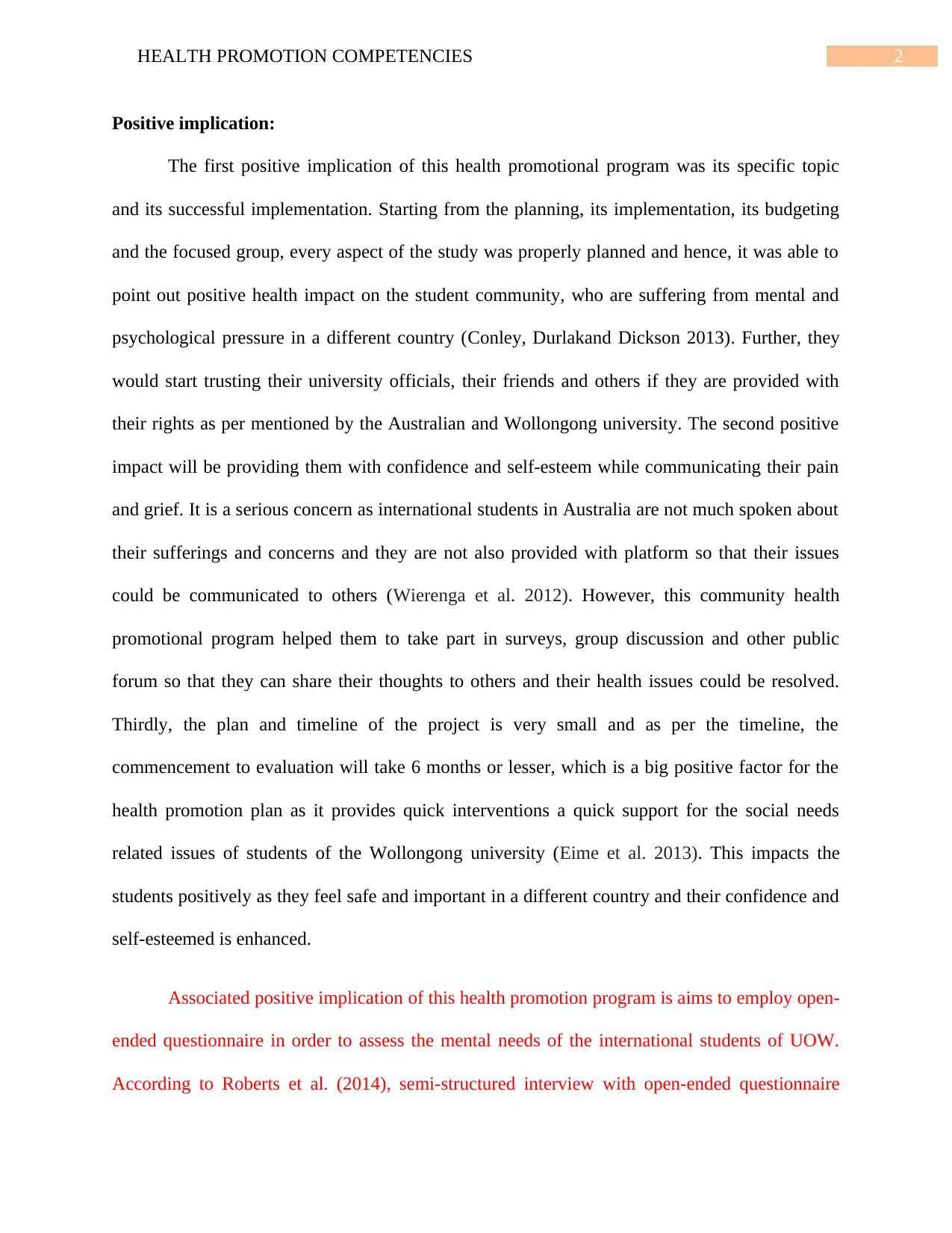
2HEALTH PROMOTION COMPETENCIES
Positive implication:
The first positive implication of this health promotional program was its specific topic
and its successful implementation. Starting from the planning, its implementation, its budgeting
and the focused group, every aspect of the study was properly planned and hence, it was able to
point out positive health impact on the student community, who are suffering from mental and
psychological pressure in a different country (Conley, Durlakand Dickson 2013). Further, they
would start trusting their university officials, their friends and others if they are provided with
their rights as per mentioned by the Australian and Wollongong university. The second positive
impact will be providing them with confidence and self-esteem while communicating their pain
and grief. It is a serious concern as international students in Australia are not much spoken about
their sufferings and concerns and they are not also provided with platform so that their issues
could be communicated to others (Wierenga et al. 2012). However, this community health
promotional program helped them to take part in surveys, group discussion and other public
forum so that they can share their thoughts to others and their health issues could be resolved.
Thirdly, the plan and timeline of the project is very small and as per the timeline, the
commencement to evaluation will take 6 months or lesser, which is a big positive factor for the
health promotion plan as it provides quick interventions a quick support for the social needs
related issues of students of the Wollongong university (Eime et al. 2013). This impacts the
students positively as they feel safe and important in a different country and their confidence and
self-esteemed is enhanced.
Associated positive implication of this health promotion program is aims to employ open-
ended questionnaire in order to assess the mental needs of the international students of UOW.
According to Roberts et al. (2014), semi-structured interview with open-ended questionnaire
Positive implication:
The first positive implication of this health promotional program was its specific topic
and its successful implementation. Starting from the planning, its implementation, its budgeting
and the focused group, every aspect of the study was properly planned and hence, it was able to
point out positive health impact on the student community, who are suffering from mental and
psychological pressure in a different country (Conley, Durlakand Dickson 2013). Further, they
would start trusting their university officials, their friends and others if they are provided with
their rights as per mentioned by the Australian and Wollongong university. The second positive
impact will be providing them with confidence and self-esteem while communicating their pain
and grief. It is a serious concern as international students in Australia are not much spoken about
their sufferings and concerns and they are not also provided with platform so that their issues
could be communicated to others (Wierenga et al. 2012). However, this community health
promotional program helped them to take part in surveys, group discussion and other public
forum so that they can share their thoughts to others and their health issues could be resolved.
Thirdly, the plan and timeline of the project is very small and as per the timeline, the
commencement to evaluation will take 6 months or lesser, which is a big positive factor for the
health promotion plan as it provides quick interventions a quick support for the social needs
related issues of students of the Wollongong university (Eime et al. 2013). This impacts the
students positively as they feel safe and important in a different country and their confidence and
self-esteemed is enhanced.
Associated positive implication of this health promotion program is aims to employ open-
ended questionnaire in order to assess the mental needs of the international students of UOW.
According to Roberts et al. (2014), semi-structured interview with open-ended questionnaire
⊘ This is a preview!⊘
Do you want full access?
Subscribe today to unlock all pages.

Trusted by 1+ million students worldwide
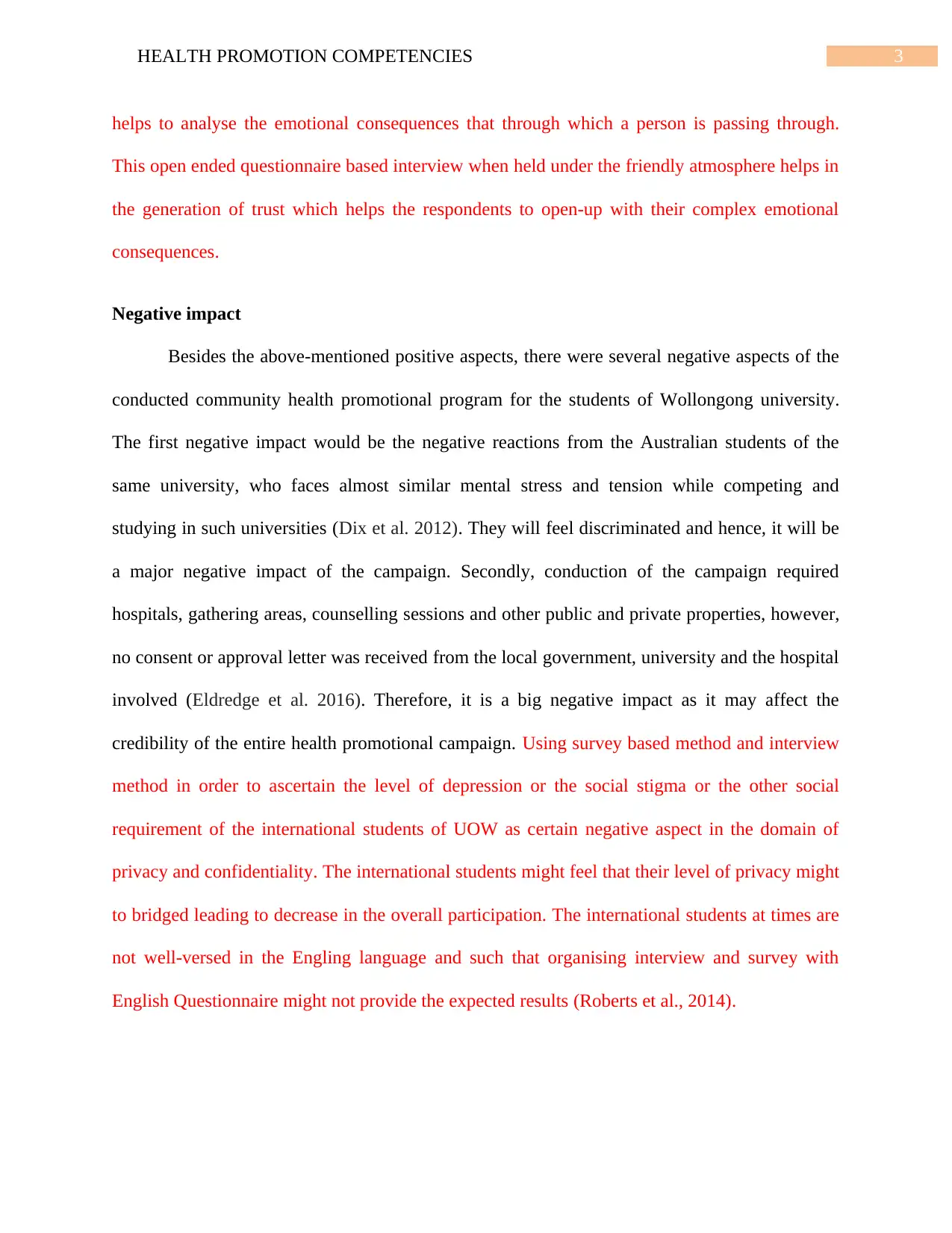
3HEALTH PROMOTION COMPETENCIES
helps to analyse the emotional consequences that through which a person is passing through.
This open ended questionnaire based interview when held under the friendly atmosphere helps in
the generation of trust which helps the respondents to open-up with their complex emotional
consequences.
Negative impact
Besides the above-mentioned positive aspects, there were several negative aspects of the
conducted community health promotional program for the students of Wollongong university.
The first negative impact would be the negative reactions from the Australian students of the
same university, who faces almost similar mental stress and tension while competing and
studying in such universities (Dix et al. 2012). They will feel discriminated and hence, it will be
a major negative impact of the campaign. Secondly, conduction of the campaign required
hospitals, gathering areas, counselling sessions and other public and private properties, however,
no consent or approval letter was received from the local government, university and the hospital
involved (Eldredge et al. 2016). Therefore, it is a big negative impact as it may affect the
credibility of the entire health promotional campaign. Using survey based method and interview
method in order to ascertain the level of depression or the social stigma or the other social
requirement of the international students of UOW as certain negative aspect in the domain of
privacy and confidentiality. The international students might feel that their level of privacy might
to bridged leading to decrease in the overall participation. The international students at times are
not well-versed in the Engling language and such that organising interview and survey with
English Questionnaire might not provide the expected results (Roberts et al., 2014).
helps to analyse the emotional consequences that through which a person is passing through.
This open ended questionnaire based interview when held under the friendly atmosphere helps in
the generation of trust which helps the respondents to open-up with their complex emotional
consequences.
Negative impact
Besides the above-mentioned positive aspects, there were several negative aspects of the
conducted community health promotional program for the students of Wollongong university.
The first negative impact would be the negative reactions from the Australian students of the
same university, who faces almost similar mental stress and tension while competing and
studying in such universities (Dix et al. 2012). They will feel discriminated and hence, it will be
a major negative impact of the campaign. Secondly, conduction of the campaign required
hospitals, gathering areas, counselling sessions and other public and private properties, however,
no consent or approval letter was received from the local government, university and the hospital
involved (Eldredge et al. 2016). Therefore, it is a big negative impact as it may affect the
credibility of the entire health promotional campaign. Using survey based method and interview
method in order to ascertain the level of depression or the social stigma or the other social
requirement of the international students of UOW as certain negative aspect in the domain of
privacy and confidentiality. The international students might feel that their level of privacy might
to bridged leading to decrease in the overall participation. The international students at times are
not well-versed in the Engling language and such that organising interview and survey with
English Questionnaire might not provide the expected results (Roberts et al., 2014).
Paraphrase This Document
Need a fresh take? Get an instant paraphrase of this document with our AI Paraphraser
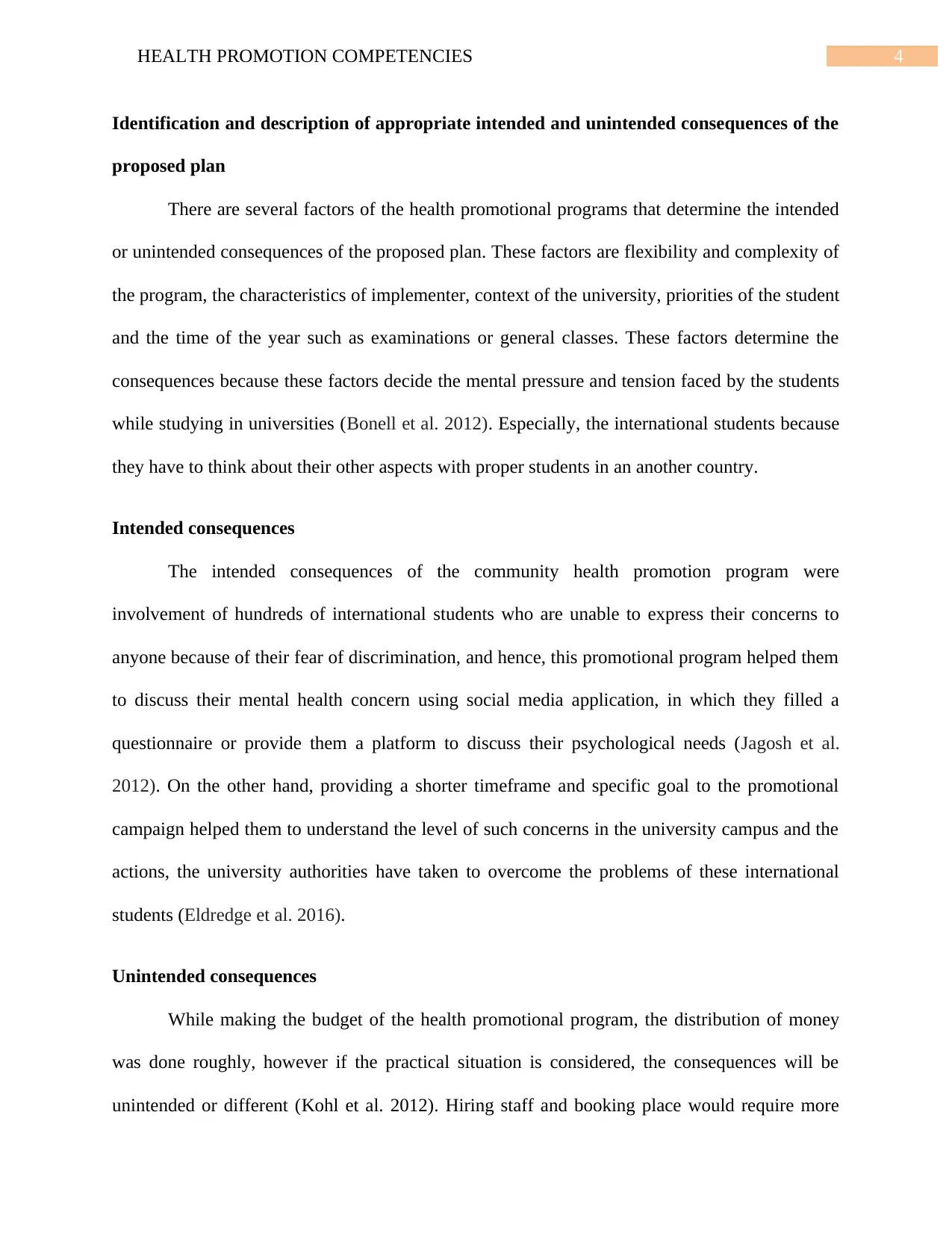
4HEALTH PROMOTION COMPETENCIES
Identification and description of appropriate intended and unintended consequences of the
proposed plan
There are several factors of the health promotional programs that determine the intended
or unintended consequences of the proposed plan. These factors are flexibility and complexity of
the program, the characteristics of implementer, context of the university, priorities of the student
and the time of the year such as examinations or general classes. These factors determine the
consequences because these factors decide the mental pressure and tension faced by the students
while studying in universities (Bonell et al. 2012). Especially, the international students because
they have to think about their other aspects with proper students in an another country.
Intended consequences
The intended consequences of the community health promotion program were
involvement of hundreds of international students who are unable to express their concerns to
anyone because of their fear of discrimination, and hence, this promotional program helped them
to discuss their mental health concern using social media application, in which they filled a
questionnaire or provide them a platform to discuss their psychological needs (Jagosh et al.
2012). On the other hand, providing a shorter timeframe and specific goal to the promotional
campaign helped them to understand the level of such concerns in the university campus and the
actions, the university authorities have taken to overcome the problems of these international
students (Eldredge et al. 2016).
Unintended consequences
While making the budget of the health promotional program, the distribution of money
was done roughly, however if the practical situation is considered, the consequences will be
unintended or different (Kohl et al. 2012). Hiring staff and booking place would require more
Identification and description of appropriate intended and unintended consequences of the
proposed plan
There are several factors of the health promotional programs that determine the intended
or unintended consequences of the proposed plan. These factors are flexibility and complexity of
the program, the characteristics of implementer, context of the university, priorities of the student
and the time of the year such as examinations or general classes. These factors determine the
consequences because these factors decide the mental pressure and tension faced by the students
while studying in universities (Bonell et al. 2012). Especially, the international students because
they have to think about their other aspects with proper students in an another country.
Intended consequences
The intended consequences of the community health promotion program were
involvement of hundreds of international students who are unable to express their concerns to
anyone because of their fear of discrimination, and hence, this promotional program helped them
to discuss their mental health concern using social media application, in which they filled a
questionnaire or provide them a platform to discuss their psychological needs (Jagosh et al.
2012). On the other hand, providing a shorter timeframe and specific goal to the promotional
campaign helped them to understand the level of such concerns in the university campus and the
actions, the university authorities have taken to overcome the problems of these international
students (Eldredge et al. 2016).
Unintended consequences
While making the budget of the health promotional program, the distribution of money
was done roughly, however if the practical situation is considered, the consequences will be
unintended or different (Kohl et al. 2012). Hiring staff and booking place would require more
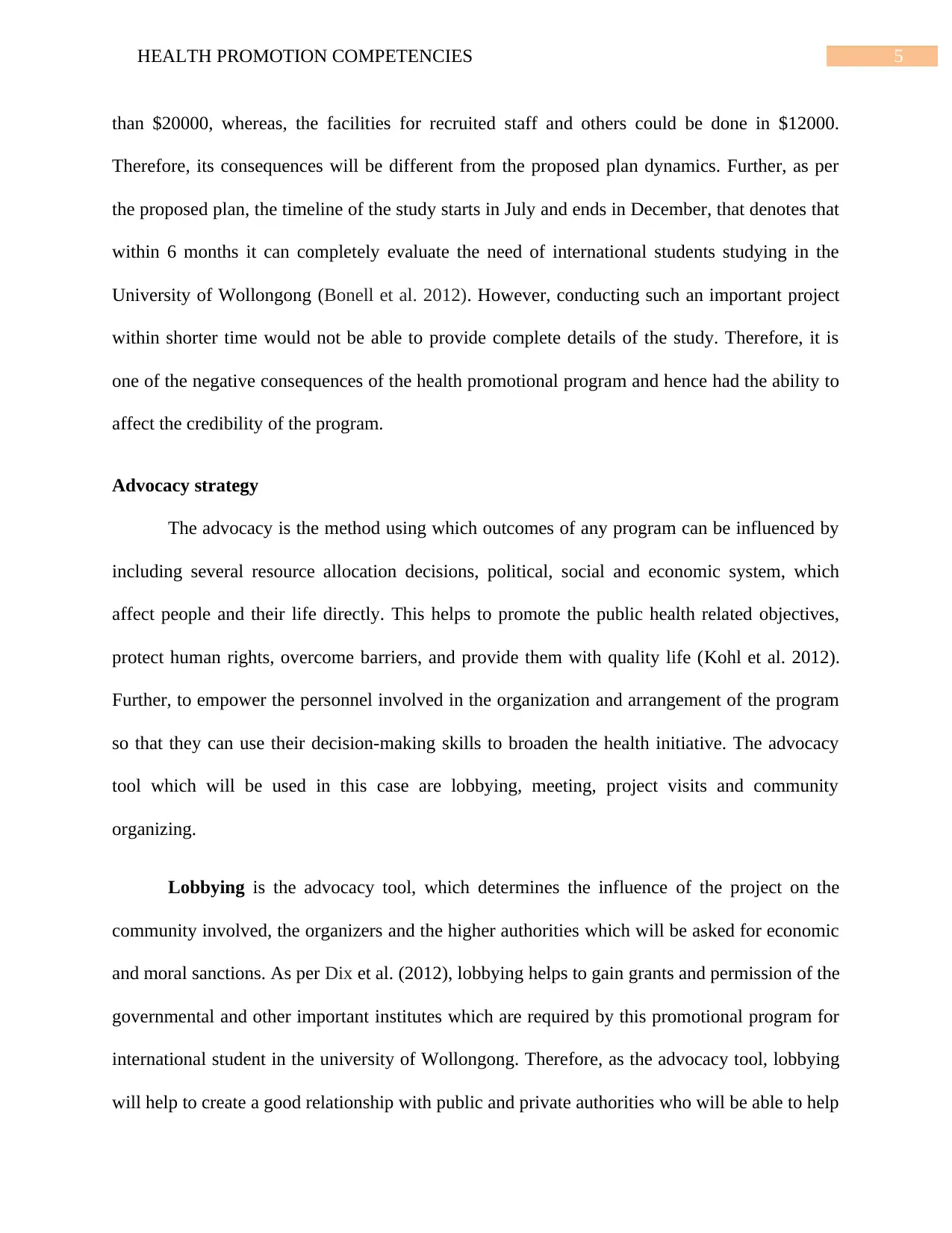
5HEALTH PROMOTION COMPETENCIES
than $20000, whereas, the facilities for recruited staff and others could be done in $12000.
Therefore, its consequences will be different from the proposed plan dynamics. Further, as per
the proposed plan, the timeline of the study starts in July and ends in December, that denotes that
within 6 months it can completely evaluate the need of international students studying in the
University of Wollongong (Bonell et al. 2012). However, conducting such an important project
within shorter time would not be able to provide complete details of the study. Therefore, it is
one of the negative consequences of the health promotional program and hence had the ability to
affect the credibility of the program.
Advocacy strategy
The advocacy is the method using which outcomes of any program can be influenced by
including several resource allocation decisions, political, social and economic system, which
affect people and their life directly. This helps to promote the public health related objectives,
protect human rights, overcome barriers, and provide them with quality life (Kohl et al. 2012).
Further, to empower the personnel involved in the organization and arrangement of the program
so that they can use their decision-making skills to broaden the health initiative. The advocacy
tool which will be used in this case are lobbying, meeting, project visits and community
organizing.
Lobbying is the advocacy tool, which determines the influence of the project on the
community involved, the organizers and the higher authorities which will be asked for economic
and moral sanctions. As per Dix et al. (2012), lobbying helps to gain grants and permission of the
governmental and other important institutes which are required by this promotional program for
international student in the university of Wollongong. Therefore, as the advocacy tool, lobbying
will help to create a good relationship with public and private authorities who will be able to help
than $20000, whereas, the facilities for recruited staff and others could be done in $12000.
Therefore, its consequences will be different from the proposed plan dynamics. Further, as per
the proposed plan, the timeline of the study starts in July and ends in December, that denotes that
within 6 months it can completely evaluate the need of international students studying in the
University of Wollongong (Bonell et al. 2012). However, conducting such an important project
within shorter time would not be able to provide complete details of the study. Therefore, it is
one of the negative consequences of the health promotional program and hence had the ability to
affect the credibility of the program.
Advocacy strategy
The advocacy is the method using which outcomes of any program can be influenced by
including several resource allocation decisions, political, social and economic system, which
affect people and their life directly. This helps to promote the public health related objectives,
protect human rights, overcome barriers, and provide them with quality life (Kohl et al. 2012).
Further, to empower the personnel involved in the organization and arrangement of the program
so that they can use their decision-making skills to broaden the health initiative. The advocacy
tool which will be used in this case are lobbying, meeting, project visits and community
organizing.
Lobbying is the advocacy tool, which determines the influence of the project on the
community involved, the organizers and the higher authorities which will be asked for economic
and moral sanctions. As per Dix et al. (2012), lobbying helps to gain grants and permission of the
governmental and other important institutes which are required by this promotional program for
international student in the university of Wollongong. Therefore, as the advocacy tool, lobbying
will help to create a good relationship with public and private authorities who will be able to help
⊘ This is a preview!⊘
Do you want full access?
Subscribe today to unlock all pages.

Trusted by 1+ million students worldwide
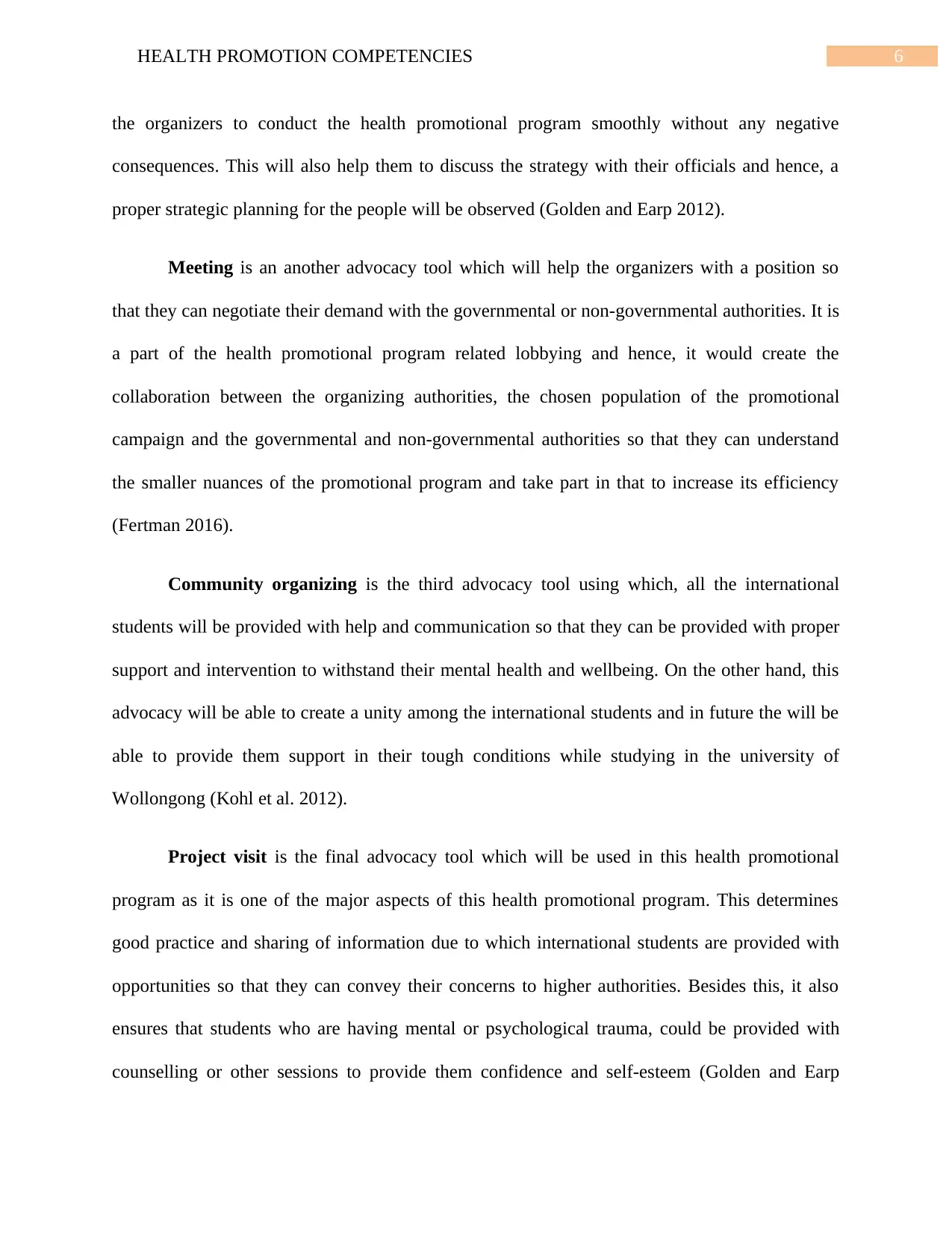
6HEALTH PROMOTION COMPETENCIES
the organizers to conduct the health promotional program smoothly without any negative
consequences. This will also help them to discuss the strategy with their officials and hence, a
proper strategic planning for the people will be observed (Golden and Earp 2012).
Meeting is an another advocacy tool which will help the organizers with a position so
that they can negotiate their demand with the governmental or non-governmental authorities. It is
a part of the health promotional program related lobbying and hence, it would create the
collaboration between the organizing authorities, the chosen population of the promotional
campaign and the governmental and non-governmental authorities so that they can understand
the smaller nuances of the promotional program and take part in that to increase its efficiency
(Fertman 2016).
Community organizing is the third advocacy tool using which, all the international
students will be provided with help and communication so that they can be provided with proper
support and intervention to withstand their mental health and wellbeing. On the other hand, this
advocacy will be able to create a unity among the international students and in future the will be
able to provide them support in their tough conditions while studying in the university of
Wollongong (Kohl et al. 2012).
Project visit is the final advocacy tool which will be used in this health promotional
program as it is one of the major aspects of this health promotional program. This determines
good practice and sharing of information due to which international students are provided with
opportunities so that they can convey their concerns to higher authorities. Besides this, it also
ensures that students who are having mental or psychological trauma, could be provided with
counselling or other sessions to provide them confidence and self-esteem (Golden and Earp
the organizers to conduct the health promotional program smoothly without any negative
consequences. This will also help them to discuss the strategy with their officials and hence, a
proper strategic planning for the people will be observed (Golden and Earp 2012).
Meeting is an another advocacy tool which will help the organizers with a position so
that they can negotiate their demand with the governmental or non-governmental authorities. It is
a part of the health promotional program related lobbying and hence, it would create the
collaboration between the organizing authorities, the chosen population of the promotional
campaign and the governmental and non-governmental authorities so that they can understand
the smaller nuances of the promotional program and take part in that to increase its efficiency
(Fertman 2016).
Community organizing is the third advocacy tool using which, all the international
students will be provided with help and communication so that they can be provided with proper
support and intervention to withstand their mental health and wellbeing. On the other hand, this
advocacy will be able to create a unity among the international students and in future the will be
able to provide them support in their tough conditions while studying in the university of
Wollongong (Kohl et al. 2012).
Project visit is the final advocacy tool which will be used in this health promotional
program as it is one of the major aspects of this health promotional program. This determines
good practice and sharing of information due to which international students are provided with
opportunities so that they can convey their concerns to higher authorities. Besides this, it also
ensures that students who are having mental or psychological trauma, could be provided with
counselling or other sessions to provide them confidence and self-esteem (Golden and Earp
Paraphrase This Document
Need a fresh take? Get an instant paraphrase of this document with our AI Paraphraser
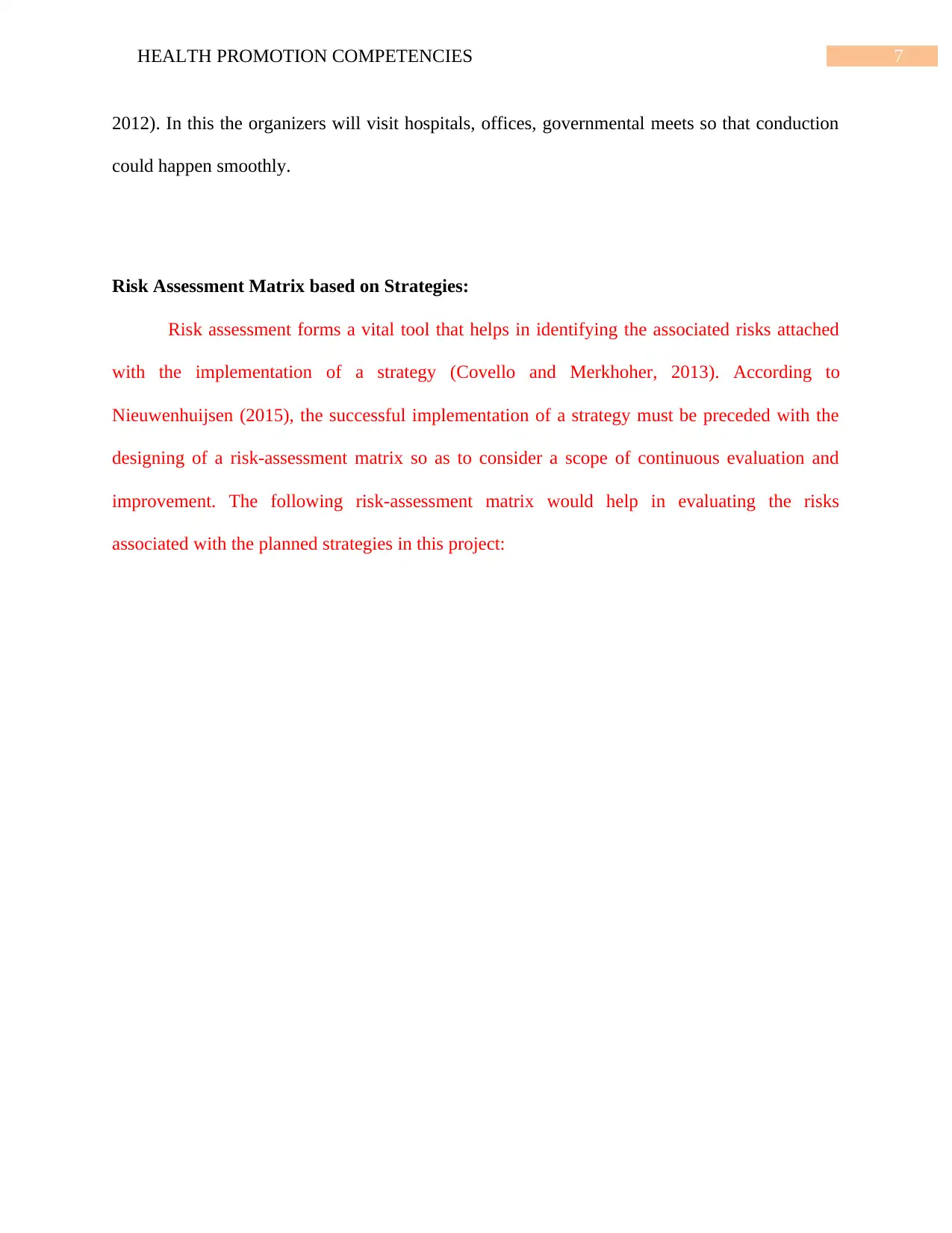
7HEALTH PROMOTION COMPETENCIES
2012). In this the organizers will visit hospitals, offices, governmental meets so that conduction
could happen smoothly.
Risk Assessment Matrix based on Strategies:
Risk assessment forms a vital tool that helps in identifying the associated risks attached
with the implementation of a strategy (Covello and Merkhoher, 2013). According to
Nieuwenhuijsen (2015), the successful implementation of a strategy must be preceded with the
designing of a risk-assessment matrix so as to consider a scope of continuous evaluation and
improvement. The following risk-assessment matrix would help in evaluating the risks
associated with the planned strategies in this project:
2012). In this the organizers will visit hospitals, offices, governmental meets so that conduction
could happen smoothly.
Risk Assessment Matrix based on Strategies:
Risk assessment forms a vital tool that helps in identifying the associated risks attached
with the implementation of a strategy (Covello and Merkhoher, 2013). According to
Nieuwenhuijsen (2015), the successful implementation of a strategy must be preceded with the
designing of a risk-assessment matrix so as to consider a scope of continuous evaluation and
improvement. The following risk-assessment matrix would help in evaluating the risks
associated with the planned strategies in this project:
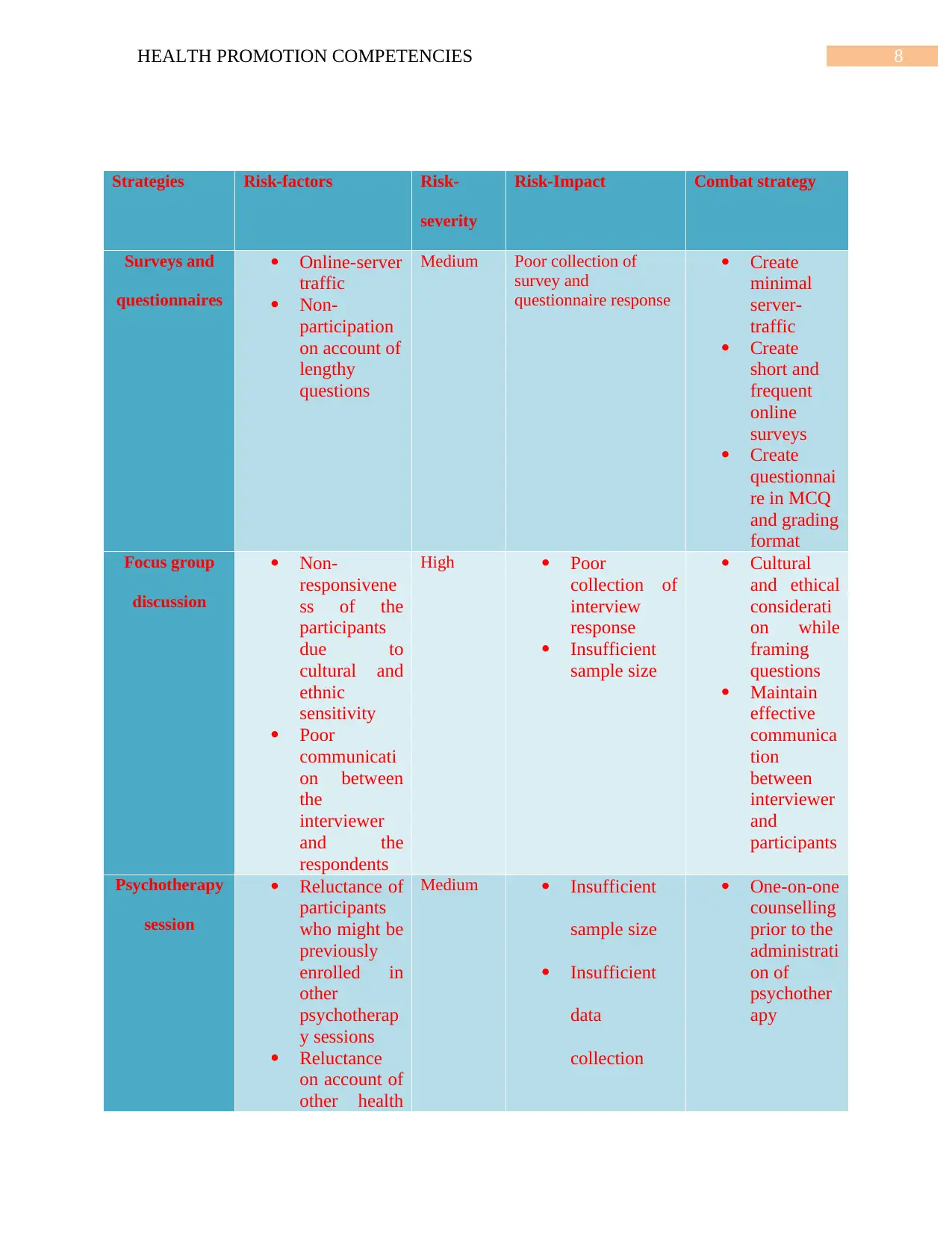
8HEALTH PROMOTION COMPETENCIES
Strategies Risk-factors Risk-
severity
Risk-Impact Combat strategy
Surveys and
questionnaires
Online-server
traffic
Non-
participation
on account of
lengthy
questions
Medium Poor collection of
survey and
questionnaire response
Create
minimal
server-
traffic
Create
short and
frequent
online
surveys
Create
questionnai
re in MCQ
and grading
format
Focus group
discussion
Non-
responsivene
ss of the
participants
due to
cultural and
ethnic
sensitivity
Poor
communicati
on between
the
interviewer
and the
respondents
High Poor
collection of
interview
response
Insufficient
sample size
Cultural
and ethical
considerati
on while
framing
questions
Maintain
effective
communica
tion
between
interviewer
and
participants
Psychotherapy
session
Reluctance of
participants
who might be
previously
enrolled in
other
psychotherap
y sessions
Reluctance
on account of
other health
Medium Insufficient
sample size
Insufficient
data
collection
One-on-one
counselling
prior to the
administrati
on of
psychother
apy
Strategies Risk-factors Risk-
severity
Risk-Impact Combat strategy
Surveys and
questionnaires
Online-server
traffic
Non-
participation
on account of
lengthy
questions
Medium Poor collection of
survey and
questionnaire response
Create
minimal
server-
traffic
Create
short and
frequent
online
surveys
Create
questionnai
re in MCQ
and grading
format
Focus group
discussion
Non-
responsivene
ss of the
participants
due to
cultural and
ethnic
sensitivity
Poor
communicati
on between
the
interviewer
and the
respondents
High Poor
collection of
interview
response
Insufficient
sample size
Cultural
and ethical
considerati
on while
framing
questions
Maintain
effective
communica
tion
between
interviewer
and
participants
Psychotherapy
session
Reluctance of
participants
who might be
previously
enrolled in
other
psychotherap
y sessions
Reluctance
on account of
other health
Medium Insufficient
sample size
Insufficient
data
collection
One-on-one
counselling
prior to the
administrati
on of
psychother
apy
⊘ This is a preview!⊘
Do you want full access?
Subscribe today to unlock all pages.

Trusted by 1+ million students worldwide
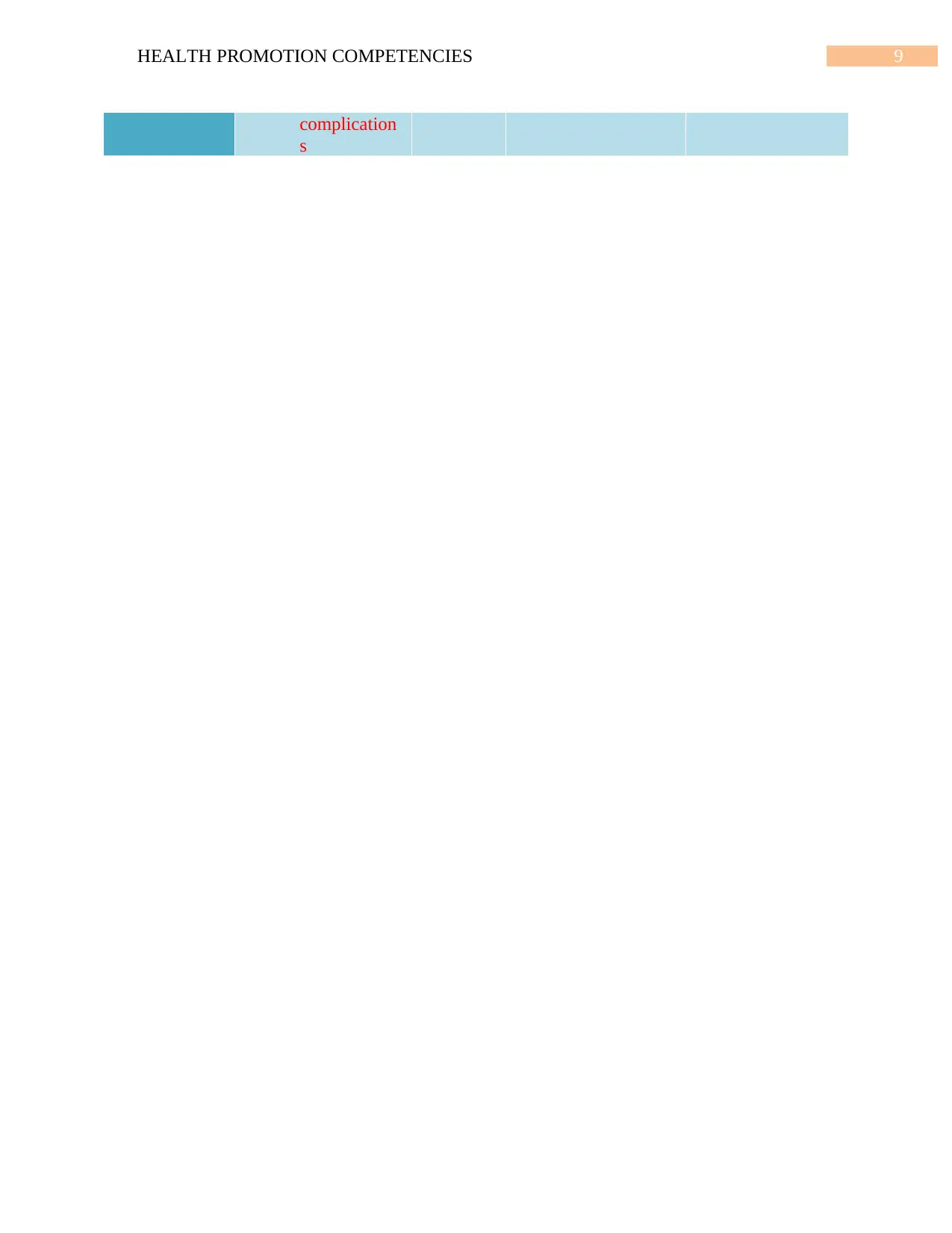
9HEALTH PROMOTION COMPETENCIES
complication
s
complication
s
Paraphrase This Document
Need a fresh take? Get an instant paraphrase of this document with our AI Paraphraser
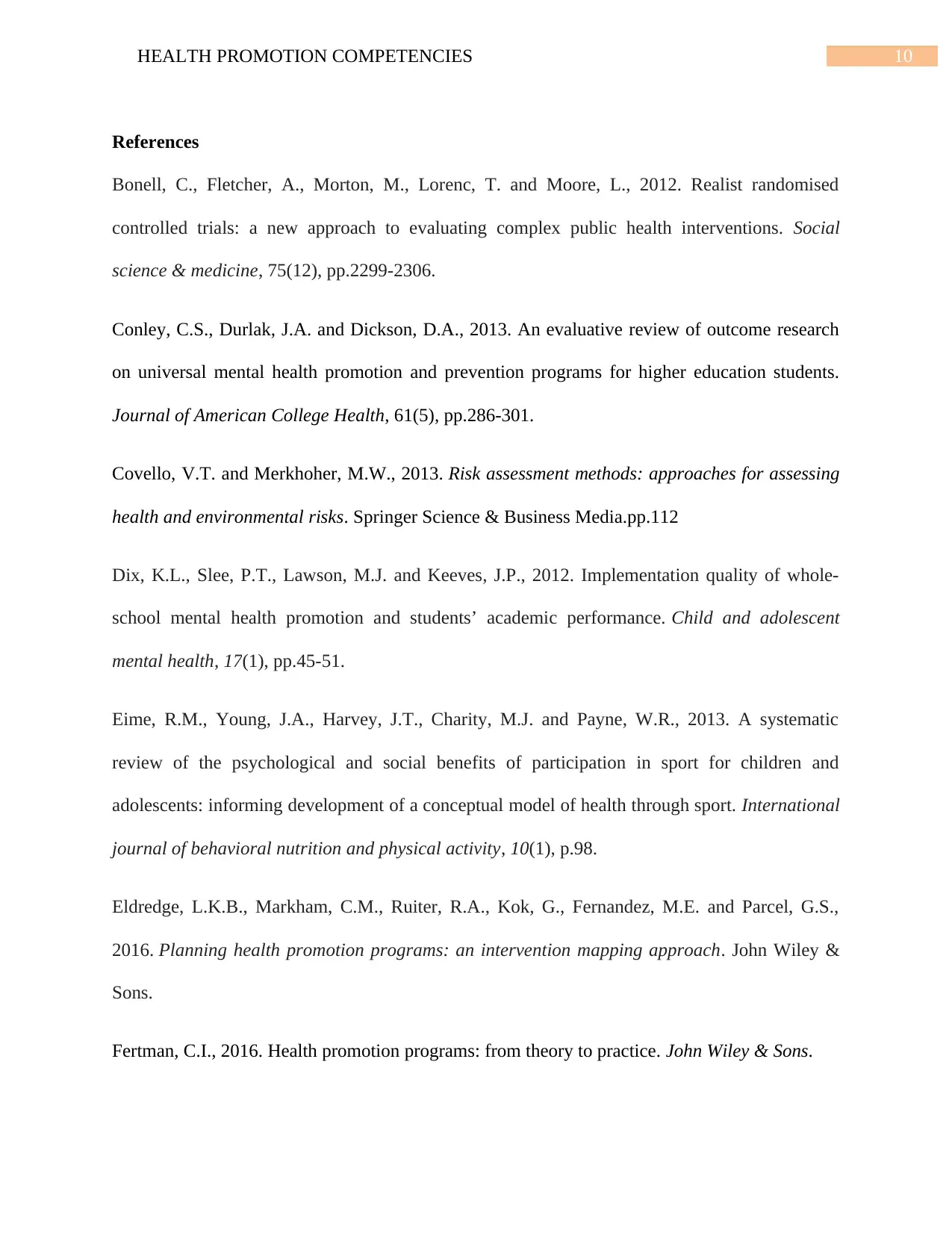
10HEALTH PROMOTION COMPETENCIES
References
Bonell, C., Fletcher, A., Morton, M., Lorenc, T. and Moore, L., 2012. Realist randomised
controlled trials: a new approach to evaluating complex public health interventions. Social
science & medicine, 75(12), pp.2299-2306.
Conley, C.S., Durlak, J.A. and Dickson, D.A., 2013. An evaluative review of outcome research
on universal mental health promotion and prevention programs for higher education students.
Journal of American College Health, 61(5), pp.286-301.
Covello, V.T. and Merkhoher, M.W., 2013. Risk assessment methods: approaches for assessing
health and environmental risks. Springer Science & Business Media.pp.112
Dix, K.L., Slee, P.T., Lawson, M.J. and Keeves, J.P., 2012. Implementation quality of whole‐
school mental health promotion and students’ academic performance. Child and adolescent
mental health, 17(1), pp.45-51.
Eime, R.M., Young, J.A., Harvey, J.T., Charity, M.J. and Payne, W.R., 2013. A systematic
review of the psychological and social benefits of participation in sport for children and
adolescents: informing development of a conceptual model of health through sport. International
journal of behavioral nutrition and physical activity, 10(1), p.98.
Eldredge, L.K.B., Markham, C.M., Ruiter, R.A., Kok, G., Fernandez, M.E. and Parcel, G.S.,
2016. Planning health promotion programs: an intervention mapping approach. John Wiley &
Sons.
Fertman, C.I., 2016. Health promotion programs: from theory to practice. John Wiley & Sons.
References
Bonell, C., Fletcher, A., Morton, M., Lorenc, T. and Moore, L., 2012. Realist randomised
controlled trials: a new approach to evaluating complex public health interventions. Social
science & medicine, 75(12), pp.2299-2306.
Conley, C.S., Durlak, J.A. and Dickson, D.A., 2013. An evaluative review of outcome research
on universal mental health promotion and prevention programs for higher education students.
Journal of American College Health, 61(5), pp.286-301.
Covello, V.T. and Merkhoher, M.W., 2013. Risk assessment methods: approaches for assessing
health and environmental risks. Springer Science & Business Media.pp.112
Dix, K.L., Slee, P.T., Lawson, M.J. and Keeves, J.P., 2012. Implementation quality of whole‐
school mental health promotion and students’ academic performance. Child and adolescent
mental health, 17(1), pp.45-51.
Eime, R.M., Young, J.A., Harvey, J.T., Charity, M.J. and Payne, W.R., 2013. A systematic
review of the psychological and social benefits of participation in sport for children and
adolescents: informing development of a conceptual model of health through sport. International
journal of behavioral nutrition and physical activity, 10(1), p.98.
Eldredge, L.K.B., Markham, C.M., Ruiter, R.A., Kok, G., Fernandez, M.E. and Parcel, G.S.,
2016. Planning health promotion programs: an intervention mapping approach. John Wiley &
Sons.
Fertman, C.I., 2016. Health promotion programs: from theory to practice. John Wiley & Sons.
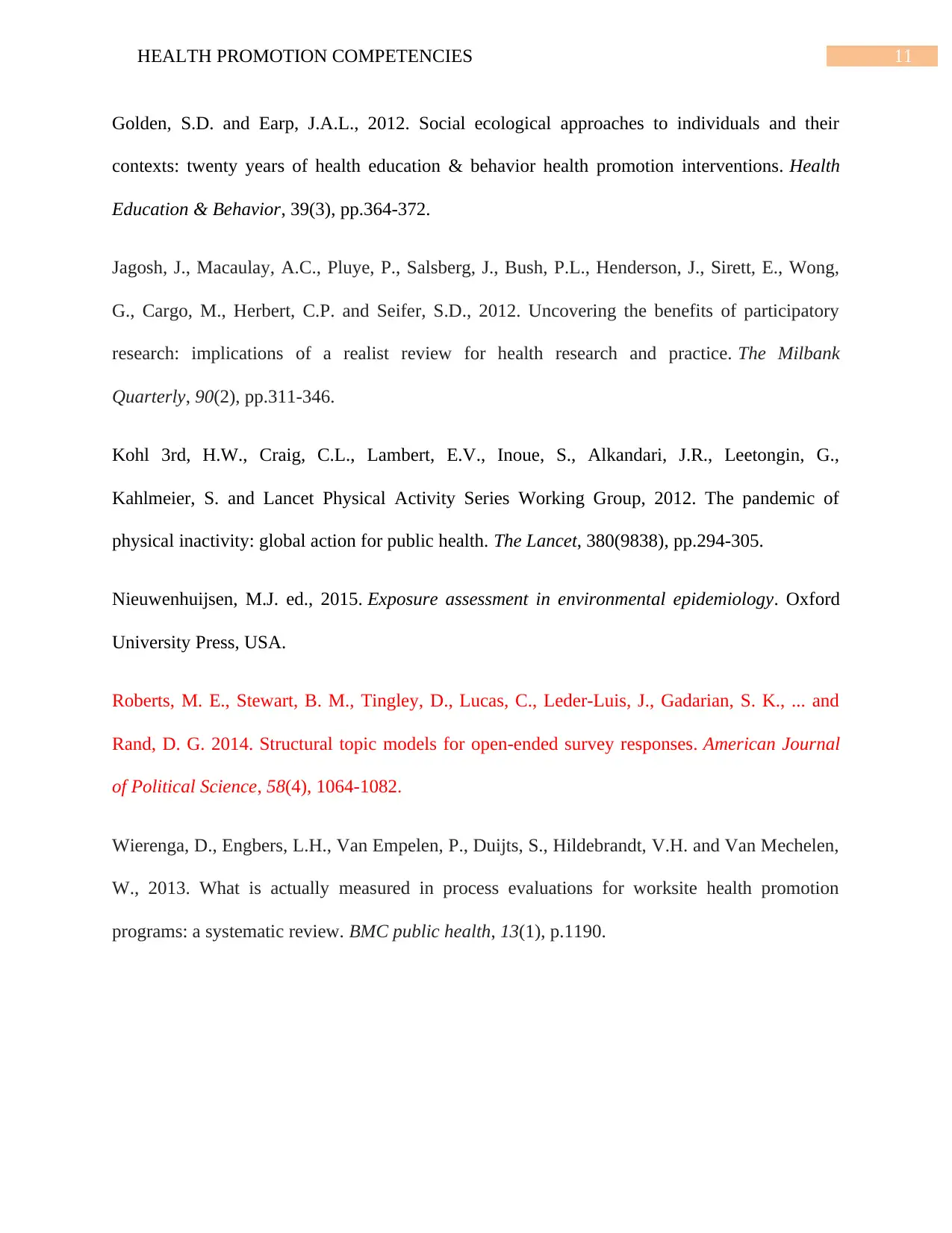
11HEALTH PROMOTION COMPETENCIES
Golden, S.D. and Earp, J.A.L., 2012. Social ecological approaches to individuals and their
contexts: twenty years of health education & behavior health promotion interventions. Health
Education & Behavior, 39(3), pp.364-372.
Jagosh, J., Macaulay, A.C., Pluye, P., Salsberg, J., Bush, P.L., Henderson, J., Sirett, E., Wong,
G., Cargo, M., Herbert, C.P. and Seifer, S.D., 2012. Uncovering the benefits of participatory
research: implications of a realist review for health research and practice. The Milbank
Quarterly, 90(2), pp.311-346.
Kohl 3rd, H.W., Craig, C.L., Lambert, E.V., Inoue, S., Alkandari, J.R., Leetongin, G.,
Kahlmeier, S. and Lancet Physical Activity Series Working Group, 2012. The pandemic of
physical inactivity: global action for public health. The Lancet, 380(9838), pp.294-305.
Nieuwenhuijsen, M.J. ed., 2015. Exposure assessment in environmental epidemiology. Oxford
University Press, USA.
Roberts, M. E., Stewart, B. M., Tingley, D., Lucas, C., Leder‐Luis, J., Gadarian, S. K., ... and
Rand, D. G. 2014. Structural topic models for open‐ended survey responses. American Journal
of Political Science, 58(4), 1064-1082.
Wierenga, D., Engbers, L.H., Van Empelen, P., Duijts, S., Hildebrandt, V.H. and Van Mechelen,
W., 2013. What is actually measured in process evaluations for worksite health promotion
programs: a systematic review. BMC public health, 13(1), p.1190.
Golden, S.D. and Earp, J.A.L., 2012. Social ecological approaches to individuals and their
contexts: twenty years of health education & behavior health promotion interventions. Health
Education & Behavior, 39(3), pp.364-372.
Jagosh, J., Macaulay, A.C., Pluye, P., Salsberg, J., Bush, P.L., Henderson, J., Sirett, E., Wong,
G., Cargo, M., Herbert, C.P. and Seifer, S.D., 2012. Uncovering the benefits of participatory
research: implications of a realist review for health research and practice. The Milbank
Quarterly, 90(2), pp.311-346.
Kohl 3rd, H.W., Craig, C.L., Lambert, E.V., Inoue, S., Alkandari, J.R., Leetongin, G.,
Kahlmeier, S. and Lancet Physical Activity Series Working Group, 2012. The pandemic of
physical inactivity: global action for public health. The Lancet, 380(9838), pp.294-305.
Nieuwenhuijsen, M.J. ed., 2015. Exposure assessment in environmental epidemiology. Oxford
University Press, USA.
Roberts, M. E., Stewart, B. M., Tingley, D., Lucas, C., Leder‐Luis, J., Gadarian, S. K., ... and
Rand, D. G. 2014. Structural topic models for open‐ended survey responses. American Journal
of Political Science, 58(4), 1064-1082.
Wierenga, D., Engbers, L.H., Van Empelen, P., Duijts, S., Hildebrandt, V.H. and Van Mechelen,
W., 2013. What is actually measured in process evaluations for worksite health promotion
programs: a systematic review. BMC public health, 13(1), p.1190.
⊘ This is a preview!⊘
Do you want full access?
Subscribe today to unlock all pages.

Trusted by 1+ million students worldwide
1 out of 12
Related Documents
Your All-in-One AI-Powered Toolkit for Academic Success.
+13062052269
info@desklib.com
Available 24*7 on WhatsApp / Email
![[object Object]](/_next/static/media/star-bottom.7253800d.svg)
Unlock your academic potential
Copyright © 2020–2025 A2Z Services. All Rights Reserved. Developed and managed by ZUCOL.





